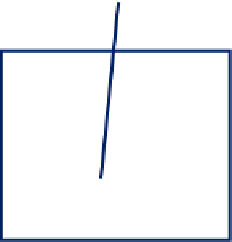Biomedical Engineering Reference
In-Depth Information
The overall effectiveness factor can be defined as
r
A
;
obs
r
A
;
b
¼
h
o
¼
h
e
h
(17.80)
Thus, the combined effect of internal mass transfer (and nonisothermal effects) and the
external mass transfer effects can be determined from the analyses of the previous sections.
Iterative solutions may be needed as the surface concentration needs to be determined in the
same time as the effectiveness factor
h
is determined.
Example 17-5
. Nitrate in groundwater is becoming more of a problem. In addition to
measures aiming at applying lower loads of fertilizers, the need for effective treatment proce-
dures is increasing. One of the alternatives investigated is removal of nitrate by conversion to
gaseous N
2
using denitrifying bacteria immobilized in gel beads. Calculate the required size
of an ideally mixed bioreactor treating 100 m
3
/h of groundwater. The concentration of nitrate
in the groundwater is 50 g/m
3
and the treated water contains 1 g/m
3
nitrate. The load of gel
beads in the reactor is 0.2 m
3
-gel/m
3
-reaction mixture. The diameter of the gel beads is
1.5 mm, the diffusivity of nitrate inside the gel is 10
10
m
2
/s. Mass transfer coefficient of
nitrate in the reactor is 10
5
m/s. The kinetic constant are given by
r
max
¼
0.4 g/(s
$
m
3
-gel)
2g
$
m
3
.
Solution
: The bioreactor is ideally well-mixed (or CSTR, as shown in
Fig. E17-5.1
); thus the
concentration of nitrate in the reactor is equal to the concentration in the effluent, i.e.
C
Ab
¼
and
K
m
¼
1g
$
m
3
. Mass balance of A (nitrate) over the CSTR gives
QC
A0
QC
Ab
þ r
A
V ¼ 0
(E17-5.1)
The reaction occurs inside the gel (particle), and nitrate must diffuse from the bulk solution to
the gel surface. Thus,
ðr
A
ÞV ¼
ðr
AS
ÞV
gel
¼ k
c
a
c
VðC
Ab
C
AS
Þ
h
(E17-5.2)
where
V
gel
is the total volume of gel particles,
r
AS
is the rate of reaction based on the gel
volume and concentration of A on the external surface of gel particle,
a
c
is the specific area
of gel external surface area (over the reactor volume), and
h
is the internal effectiveness factor.
Q
Feed
C
A0
V
Q
C
Ab
Effluent
C
Ab
A
FIGURE E17-5.1
A schematic of the CSTR water treatment system.



















Search WWH ::

Custom Search